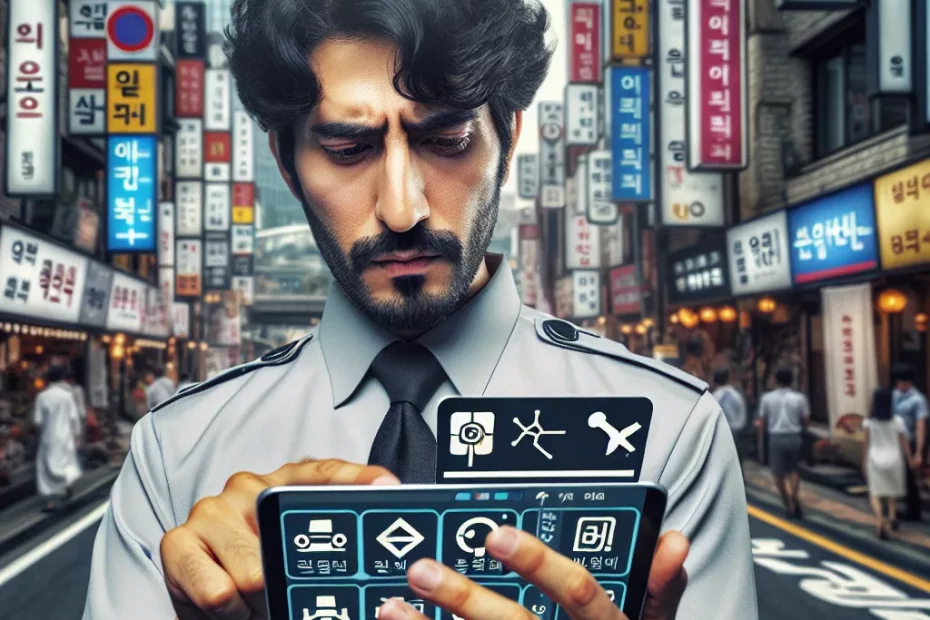As a foreign driver in Korea, understanding Korean road signs is crucial for safe and efficient navigation. The road signs in Korea may differ from those in your home country, so it’s essential to familiarize yourself with the various types and meanings. By knowing the common symbols and special regulations for foreign drivers, you can ensure a smooth driving experience on Korean roads. This guide will provide you with valuable information to help you navigate the roads of Korea confidently and safely.

Types of Korean Road Signs
Welcome to a comprehensive guide on the various types of Korean road signs that foreign drivers may encounter while navigating the roads of South Korea! Understanding these signs is crucial for safe and efficient driving in a foreign country. Let’s delve into the different categories of Korean road signs to help you become a savvy and informed driver on Korean roads! 🚗🇰🇷
Regulatory Signs
Regulatory signs in Korea are designed to inform drivers of specific laws and regulations that must be followed on the road. These signs are crucial for maintaining order and safety. Examples of regulatory signs in Korea include speed limit signs, stop signs, no entry signs, and yield signs. Remember, obeying these signs is essential for safe driving practices! 🚦⛔
Warning Signs
Warning signs in Korea are intended to alert drivers to potential hazards or changes in road conditions ahead. These signs are crucial for drivers to anticipate and react to potential dangers effectively. Common warning signs in Korea include signs for sharp curves, pedestrian crossings, slippery roads, and animal crossings. Stay vigilant and heed these warning signs for a smooth driving experience! ⚠️🚸
Informational Signs
Informational signs in Korea provide drivers with essential information about the road, directions, services, and facilities available nearby. These signs are helpful for navigation and ensuring drivers are aware of nearby amenities. Examples of informational signs in Korea include signs for gas stations, rest areas, hospitals, and tourist attractions. Pay attention to these signs to make informed decisions while driving! 📍⛽
Construction Signs
Construction signs in Korea are temporary signs that inform drivers of ongoing road work, detours, and construction zones. These signs are crucial for ensuring the safety of both drivers and construction workers. Examples of construction signs in Korea include signs for road closures, detour routes, and construction speed limits. Exercise caution and follow the instructions on these signs when driving through construction zones! 🚧👷
Directional Signs
Directional signs in Korea provide drivers with guidance on routes, exits, and destinations. These signs are essential for navigation and ensuring drivers reach their intended destinations efficiently. Examples of directional signs in Korea include signs for highways, exits, cities, and landmarks. Follow these signs to stay on the right path and reach your destination hassle-free! 🛣️🗺️
By familiarizing yourself with these different types of Korean road signs, you’ll be better equipped to navigate the roads with confidence and safety. Remember to always stay alert, follow the rules of the road, and respect the traffic signs to ensure a smooth driving experience in South Korea! Safe travels! 🚦🚗🇰🇷
Meanings of Common Korean Road Symbols
When driving in South Korea, it is essential to understand the various road symbols and signs to ensure a safe and smooth journey. Here are some common Korean road symbols that foreign drivers should be familiar with:
1. 주행로 (Main Road)
주행로 (Main Road): This symbol indicates the main road or highway, where drivers have the right of way. It is crucial to yield to vehicles on the main road when entering from a side street.
2. 정지선 (Stop Line)
정지선 (Stop Line): The stop line is a thick white line painted on the road before intersections. Drivers must come to a complete stop behind this line when the traffic light is red.
3. 우회전 전용 (Right Turn Only)
우회전 전용 (Right Turn Only): This symbol signifies a lane that is designated for right turns only. Make sure to use your turn signal and move to the right lane if you intend to turn right at the upcoming intersection.
4. 버스 전용 차로 (Bus Lane)
버스 전용 차로 (Bus Lane): The bus lane is reserved for buses only during specific hours. Unauthorized vehicles are not allowed to enter this lane during the designated times.
5. 주차 금지 (No Parking)
주차 금지 (No Parking): This symbol indicates areas where parking is prohibited. Violators may face fines or have their vehicles towed, so it is essential to adhere to these restrictions.
6. 속도 제한 (Speed Limit)
속도 제한 (Speed Limit): The speed limit sign displays the maximum speed allowed on that particular road. It is crucial to obey speed limits to ensure the safety of all road users.
7. 차로 변경 (Lane Change)
차로 변경 (Lane Change): This symbol indicates that drivers can switch lanes to the left or right. Make sure to check your blind spots, use your turn signal, and merge safely into the desired lane.
8. 도로 위험 (Road Hazard)
도로 위험 (Road Hazard): When you see this symbol, be prepared for potential road hazards ahead, such as construction zones, potholes, or debris. Slow down and proceed with caution.
By understanding these common Korean road symbols, foreign drivers can navigate the roads in South Korea with confidence and safety. Remember to stay alert, follow traffic rules, and respect other drivers on the road to ensure a pleasant driving experience. Safe travels! 🚗🚦
Special Regulations for Foreign Drivers in Korea
Welcome to our guide on special regulations for foreign drivers in Korea! Driving in a foreign country can be a challenging experience, especially when it comes to understanding the local road signs and regulations. In Korea, there are specific rules and guidelines that foreign drivers need to be aware of to ensure a safe and smooth driving experience.
Traffic Signs and Signals
Traffic Signs and Signals: When driving in Korea, it is crucial to familiarize yourself with the local traffic signs and signals. For example, the red light means stop, the green light means go, and the yellow light indicates that you should prepare to stop. Additionally, pay close attention to pedestrian crosswalks and zebra crossings, as pedestrians have the right of way.
Speed Limits
Speed Limits: Speed limits in Korea vary depending on the type of road you are driving on. In urban areas, the speed limit is usually 60 km/h, while on highways it can range from 80 km/h to 120 km/h. Be sure to adhere to the posted speed limits to avoid fines or penalties.
Parking Regulations
Parking Regulations: Parking in Korea can be quite challenging, especially in crowded urban areas. Make sure to park only in designated parking areas and avoid illegal parking, as it can result in your vehicle being towed or fined. Look out for no-parking signs and designated parking zones to avoid any inconvenience.
Driving Under the Influence
Driving Under the Influence: Just like in many other countries, driving under the influence of alcohol or drugs is strictly prohibited in Korea. The legal blood alcohol limit is 0.05%, and severe penalties, including fines and license suspension, can be imposed for violating this regulation. It is always best to designate a sober driver or use public transportation if you plan on drinking.
Emergency Services
Emergency Services: In case of an emergency while driving in Korea, dial 112 for police, 119 for fire and ambulance services. It is essential to know these emergency numbers and be prepared to provide your location and details of the situation in case of an accident or emergency.
By understanding and following these special regulations for foreign drivers in Korea, you can ensure a safe and enjoyable driving experience during your time in this beautiful country. Remember, safety always comes first on the road!
Drive safely and enjoy your time exploring the roads of Korea!
Tips for Safely Navigating Korean Roads
Welcome to our comprehensive guide on understanding Korean road signs and navigating the roads safely as a foreign driver in South Korea! Driving in a foreign country can be a daunting experience, but with the right knowledge and preparation, you can confidently explore the beautiful landscapes of Korea while ensuring your safety and the safety of others on the road. Let’s dive into some essential tips to help you navigate Korean roads like a pro! 🚗🇰🇷
1. Familiarize Yourself with Korean Road Signs
Before hitting the road, take the time to familiarize yourself with Korean road signs. Understanding the meaning of common signs such as speed limits, stop signs, and directional indicators will help you navigate the roads with ease. Keep an eye out for important signs such as “주차금지” (No Parking), “직진” (Straight), and “우회전” (Right Turn) to ensure you follow the rules and regulations.
2. Observe Speed Limits and Traffic Rules
In South Korea, speed limits are strictly enforced to ensure road safety. Be mindful of the speed limits indicated on the road signs and adjust your driving accordingly. Remember, the speed limit on urban roads is usually 60 km/h, while highways have varying limits. Always adhere to traffic rules, such as wearing seat belts and refraining from using your phone while driving, to avoid fines and ensure a safe journey.
3. Stay Alert for Pedestrians and Bicycles
Korean cities are bustling with pedestrians and cyclists, especially in urban areas. Stay vigilant and watch out for pedestrians crossing the road and cyclists sharing the lanes. Be prepared to yield to pedestrians at crosswalks and give cyclists plenty of space to maneuver safely. By respecting other road users, you contribute to a safer driving environment for everyone.
4. Use Navigation Apps for Assistance
Navigating unfamiliar roads can be challenging, but with the help of navigation apps like KakaoMap or Naver Maps, you can easily find your way around Korea. These apps provide real-time traffic updates, alternative routes, and voice-guided directions to help you reach your destination efficiently. Embrace technology to enhance your driving experience and reduce the stress of getting lost.
5. Be Mindful of Bus and Bicycle Lanes
In Korean cities, bus and bicycle lanes are designated to improve traffic flow and ensure the safety of public transport users and cyclists. Avoid driving in these lanes unless making a right turn or as indicated by road signs. Respect the designated lanes to prevent accidents and maintain a smooth traffic flow throughout your journey.
By following these tips and staying informed about Korean road regulations, you can navigate the roads with confidence and enjoy a safe driving experience in South Korea. Remember, safety should always be your top priority when behind the wheel. Happy driving! 🚦🛣️
As a foreign driver in Korea, understanding Korean road signs is crucial for your safety and compliance with local regulations. By familiarizing yourself with the types of road signs and their meanings, you can navigate Korean roads confidently. Remember to pay special attention to common symbols like speed limits, no parking zones, and pedestrian crossings. Additionally, be aware of the special regulations that apply to foreign drivers in Korea, such as the requirement to carry an International Driving Permit. To ensure a safe driving experience, always follow traffic rules, stay alert, and respect other drivers on the road. Safe travels on Korean roads!
